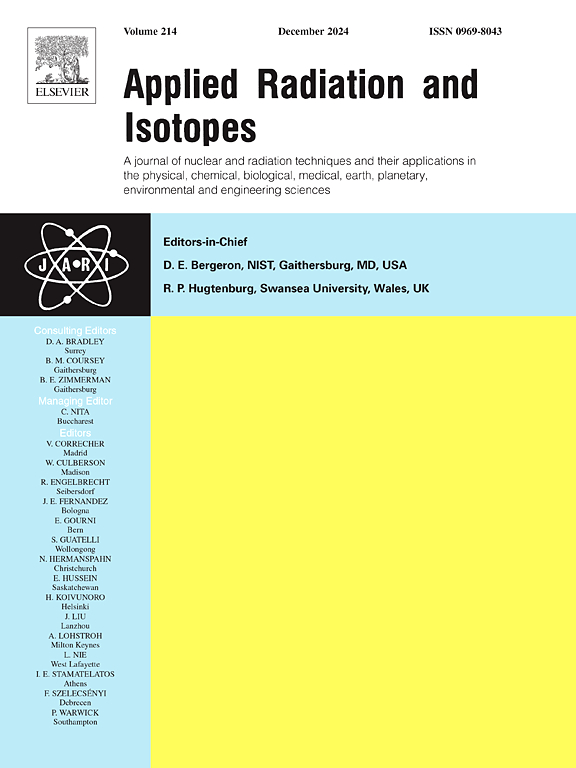Investigation of thermal, acoustic, mechanical, and radiation shielding performance of waste and natural fibers
IF 1.6
3区 工程技术
Q3 CHEMISTRY, INORGANIC & NUCLEAR
引用次数: 0
Abstract
It is crucial to address two pressing global issues, energy shortage and environmental pollution, when producing building insulation materials. Using waste and natural fiber groups can be part of the solution. The insulation material was produced using pumpkin fiber, chicken fiber, cotton waste, vermiculite, and epoxy as binders. The samples were tested for thermal conductivity coefficient, ultrasonic sound transmission rate, density, water absorption rate, compressive and bending strength, and fire resistance at temperatures of 75, 100, 125, and 150C. The samples produced using natural and waste materials yielded a thermal conductivity value of 0.041 W/mK, an ultrasonic sound transmission speed of 0.25 km/s, a compressive strength value of 1.57 MPa, and bending strength values of 0.91 MPa. It has been clearly demonstrated that, with its low volume loss, it can serve as an alternative to the EPS-XPS types available in the market. Furthermore, the linear attenuation coefficients (LAC) were examined to obtain radiation shielding properties of the samples at 1173 and 133 keV energies using a 60Co gamma source. Also, LAC values determined between 0,1167 ± 0,0452 cm−1-0,2315 ± 0,0065 cm−1 for 1173 keV and 0,1042 ± 0,0488 cm−1 - 0,2141 ± 0,0062 cm−1 for 1333 keV. Accordingly, it has been revealed that waste compositions are effective in protecting against radiation.
研究废纤维和天然纤维的热屏蔽、声屏蔽、机械屏蔽和辐射屏蔽性能。
在生产建筑保温材料时,解决能源短缺和环境污染这两个紧迫的全球性问题至关重要。利用废弃物和天然纤维群可以成为解决方案的一部分。使用南瓜纤维、鸡纤维、棉花废料、蛭石和环氧树脂作为粘合剂,生产出了隔热材料。测试了样品的导热系数、超声波透射率、密度、吸水率、抗压和抗弯强度,以及在 75、100、125 和 150 摄氏度下的耐火性。使用天然材料和废料制作的样品的导热系数为 0.041 W/mK,超声波传播速度为 0.25 km/s,抗压强度为 1.57 MPa,抗弯强度为 0.91 MPa。研究清楚地表明,这种材料的体积损失小,可以替代市场上的 EPS-XPS 类型。此外,通过检测线性衰减系数(LAC),利用 60Co 伽马源获得了样品在 1173 和 133 keV 能量下的辐射屏蔽特性。此外,在 1173 千伏时,LAC 值为 0,1167 ± 0,0452 厘米-1-0,2315 ± 0,0065 厘米-1;在 1333 千伏时,LAC 值为 0,1042 ± 0,0488 厘米-1-0,2141 ± 0,0062 厘米-1。由此可见,废物成分能有效抵御辐射。
本文章由计算机程序翻译,如有差异,请以英文原文为准。
求助全文
约1分钟内获得全文
求助全文
来源期刊

Applied Radiation and Isotopes
工程技术-核科学技术
CiteScore
3.00
自引率
12.50%
发文量
406
审稿时长
13.5 months
期刊介绍:
Applied Radiation and Isotopes provides a high quality medium for the publication of substantial, original and scientific and technological papers on the development and peaceful application of nuclear, radiation and radionuclide techniques in chemistry, physics, biochemistry, biology, medicine, security, engineering and in the earth, planetary and environmental sciences, all including dosimetry. Nuclear techniques are defined in the broadest sense and both experimental and theoretical papers are welcome. They include the development and use of α- and β-particles, X-rays and γ-rays, neutrons and other nuclear particles and radiations from all sources, including radionuclides, synchrotron sources, cyclotrons and reactors and from the natural environment.
The journal aims to publish papers with significance to an international audience, containing substantial novelty and scientific impact. The Editors reserve the rights to reject, with or without external review, papers that do not meet these criteria.
Papers dealing with radiation processing, i.e., where radiation is used to bring about a biological, chemical or physical change in a material, should be directed to our sister journal Radiation Physics and Chemistry.
 求助内容:
求助内容: 应助结果提醒方式:
应助结果提醒方式:


